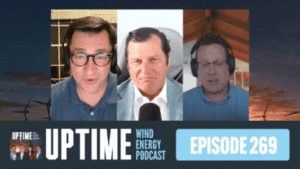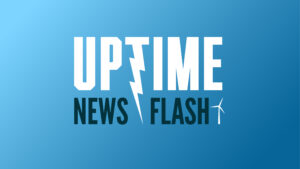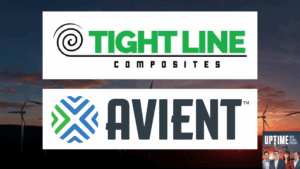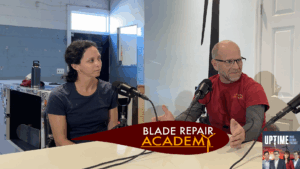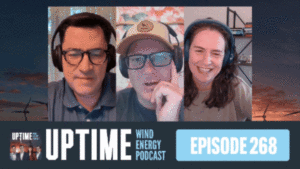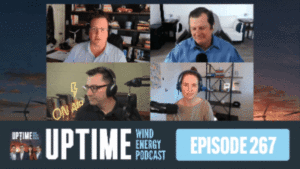Podcast: Play in new window | Download
Diane Waghorne, founder of Tech Safety Lines (TSL), and instructor Matt Wehrle explain their approach to wind technician safety training. Allen and Joel had the pleasure of visiting their excellent facility in Dallas, Texas and discuss their impact on the industry. Drawing on expertise from fire and rescue professionals, TSL prepares technicians for high-stress rescue scenarios. The company’s global recognition for providing top-quality training is evidenced by their GWO Training Team of the Americas Award. TSL initially began with selling the military compact descender and has recently had their SRK rescue kit certified to ANSI Z359.9 standards.
Sign up now for Uptime Tech News, our weekly email update on all things wind technology. This episode is sponsored by Weather Guard Lightning Tech. Learn more about Weather Guard’s StrikeTape Wind Turbine LPS retrofit. Follow the show on Facebook, YouTube, Twitter, Linkedin and visit Weather Guard on the web. And subscribe to Rosemary Barnes’ YouTube channel here. Have a question we can answer on the show? Email us!
Pardalote Consulting – https://www.pardaloteconsulting.com
Weather Guard Lightning Tech – www.weatherguardwind.com
Intelstor – https://www.intelstor.com
Allen Hall: Welcome to the Uptime Wind Energy Podcast. I’m your host, Allen Hall, along with my co host, Joel Saxum. Today, we’re diving into a crucial topic that affects every professional in our industry, and that’s training. As the wind energy sector continues to grow rapidly, the need for standardized high quality safety training has never been more critical.
GWO training has become the gold standard for ensuring that the wind industry professionals are equipped with the essential skills and knowledge to work safely and efficiently. Our guest today is Diane Waghorn, president and CEO of Tech Safety Lines, and Matt Wehrle, Tech Safety Lines instructor as well as a firefighter and paramedic.
Tech Safety Lines is based in Dallas, Texas. And from their founding, Tech Safety Lines has been focused on safety through their start with the Military Compact Descender, to a series of safety products, and now with GWO training, Tech Safety Lines is a leader in wind energy safety. In fact, Tech Safety Lines recently received the GWO Training Team of the Year Americas Award.
Diane and Matt, welcome to the show. Thank you for having us. This is exciting because Joel and I visited the tech safety lines facility a little while ago and we’re just super impressed. I don’t know how else to describe
Joel Saxum: it, Joel. Yeah, blown away. It was a great facility. Yeah, from the time, we met Diane when we walked in to everybody that we ran into in the facility, shaking hands, Hi, nice to meet you.
Who are you guys? Welcome in. Let’s show you this. Let’s show you that. Everything clean, ready to go. It was an impressive facility, to say the least.
Diane Waghorne: Oh, thank you so much. We’re very proud of our facility and we just welcome visitors and I’m glad you had a good time seeing our facility and allowing us the opportunity to share our instructors with you.
It was just a great time.
Allen Hall: Diane, I think we ought to start with A little bit of your history, because it is so unique to the industry. You really got your start after 9 11 with something called the military compact descender. You want to just touch on how that all got kicked off?
Diane Waghorne: I’d be happy to, um, when 9 11 happened during that time period, I was a stay at home mom.
And I’ve been a business major in college, but then when I had my children, I wanted to stay home with them. And when 9 11 happened, my son was in college and my daughter just turned 16 and got her driver’s license. If I was ever going to go back into the workforce, that was a good time for me. And when I witnessed what happened with horror, as we all did, we just could not believe what we were seeing on our televisions.
I just had this gut feeling that there could have been something, there had to be something. And I thought, the United States military, surely they had something. So I, we had Google back then and you, you start networking and I heard of a product called the Military Combat Descender. And back then it was only on paper.
But Cape Roads is a military manufacturing plant in Connecticut, and they were tasked with finding a way for our servicemen to descend with one hand and have their weapon hand ready. And It was on this miraculous rope that was very small. Back then it was only a three millimeter rope. I think Fort Bragg may still have that three millimeter rope, but I visited with them, I flew out to see them, and it was really astonishing they even gave me an interview, because you just don’t do that, a housewife from Dallas, Texas, but back then no one trusted anybody, so they said I could come out.
And I think I got on a plane with only 2 other people on the plane. This was about 3 weeks after 9, 11, if we can remember those days, and I just met with them and said, look, I’ve heard of this military compact to sender my only ask is that when it’s available now, please bring it to the SWAT leaders and the firefighters in my state of Texas.
And that’s how it started. I started off my kitchen table. I became a distributor for them. I started doing different. SWAT shut us, but then. Meeting different people and started making some sales. Then long story short, I ended up buying the patent and brought the manufacturing here in Texas. And now I owe my husband some money because I bought this patent from the Rockefeller family.
And I say, okay, what am I going to do now? So I went after the largest construction company in the world. I went after Bechtel and they saw the product. They loved the product. And they said you’re going to have to train in order for us to provide, this to our people. Again, I’m a state home mom, and I did not know anything about training.
I went to the city of Dallas and asked to speak to the chief, who would not see me, and passed the note to the captain Captain Brent Wise. And I made a batch of homemade chocolate chip cookies. I went to the I popped open my Tupperware and that’s how we all got started. He’s a top notch holland. We wrote the curriculum and we became the seventh company globally authorized to train for Bechtel.
So we’ve been to Angola, Africa, to LNG plants. The company now, I believe we have 40, 000 square feet of training here. I believe I’m in 35 different countries. We have over 50, 000 military combat dissenters. People often say, how the heck did this happen? To me, we all have most of us have someone to me is a superior force.
I, I don’t take credit for this. I was guided to this and I’m very passionate about this and I’m very dedicated. I really don’t even think that I work. I think it’s just such a miracle that I am blessed to be with great people like Matt Wehrle is one of our instructors. He’s on the city of Dallas. He’s on the Urban Search and Rescue, Task Force One, and all of that.
And part of being a business owner is to be smart enough to surround yourself by great people. And so I have Matt, and I have so many great people here. But I’d love for Matt to be able to tell you a little bit more about the training because the training is really what sets us apart. Yes, we have a great equipment.
There’s other great equipment out there, but it’s really the training, I think, is the importance of making sure that your employees get the right training, the proper training. To ensure that they go home to their families every day, just like we get to when they should be able to as well.
Allen Hall: I think that’s where tech safety lines may differ from a lot of other manufacturers of equipment, of safety equipment, right?
That the manufacturers of safety equipment are not really in the training business, so to speak. But you have taken a slightly different approach where you have a, now a series of safety products that if you go to techsafetylines. com, you can just check them out online. That website is exceptional, so it’s easy to see and browse through.
But the more important piece of this is getting trained in that equipment and to know what to do in an emergency situation. And that’s where Matt comes in, that, Dad, you brought in some real experts, people that, that work in emergency services to train the WIND technicians in particular, of all the things to think about or be prepared for when an emergency situation happens.
When Joel and I visited, that’s why we were so impressed. Everybody we met either had come from a fire or ambulance or some sort of situation like that. And that’s an everyday event for fire rescue people. And that’s why Matt’s so important here. And Matt. When you bring people into your training program, you’re just not showing them how to clip on a harness, right?
You’re trying to provide them more instructions on what to be aware of, right?
Matt Wehrle: Yeah, absolutely. There’s so much more that goes into the rescue, the training, the aspect of what’s the implementation of that when this event actually goes down in the field. I think we’ve often taken training for granted.
Just, name, whatever training you’ve been to, we’ve all been to some form of training. We’ve got lists of it. Yeah, hands up, right? We’ve all done it. It’s check the box. I’ll show you how to do this. It’s more of a monkey see monkey do. You did it. Great. You move on. We like to train more of a cultural aspect, right?
And that all starts from the top gallery. Talked about the facility, how Diane sets the stage for our culture here. And that trickle down effect happens through our instructors. And then once we get to the floor and we get training with the students, the idea is not just. ABC and D move on down the road.
The idea is how do we train that theoretical approach? So nine, 10, 12, two years, months from now, we can replicate this rescue to success. And as we talked about earlier, Joel, Manage anxiety in the moment of rescuing people I think that’s something that’s grossly underutilized in this industry is the acknowledgement of what it’s like to rescue people that you potentially know and develop relationships with.
Because these wind technicians, they’re in remote places all across North America, if not the world. They’re working in crew sizes of, varying sizes, three, six, seven, eight, nine on MCE, large construction crews. And they’re going to end up developing personal relationships and becoming friends and close acquaintances amongst themselves.
That’s different than what I do on a daily basis in the fire service. Generically, 99. 9 percent of the time, we’re going to rescue people that we’ve never met before. So it’s very much a kind of cut and dry revert back to the training. I have a well trained crew that’s prepared for the moment that we get to work with every third day.
Now we’re trying to prepare these folks to manage that anxiety where they maybe get to do a remedial training. Once a month, we at least once a quarter, we hope, and how do we, from a cultural aspect, teach them to manage that anxiety in that moment to be successful? That’s really, that, that is one of the main things that our training helped dictate.
We get into all sorts of different theoretical approach of training, whether it’s crawl, walk, run mentalities, and there’s a various amount of things and tools we use to get the students there, but ultimately, it’s how is this repeatable? Not tomorrow, the day they leave training, 9, 10, 11, 12 months from now, when they’re out in remote West Texas, having to pull this off on someone that they know and care about.
That’s really our kind of our main angle there at the end result.
Joel Saxum: Yeah, I’d say like we talked about earlier when we visited the facility and how great it was. It was full. You guys had, there was 40, 50 people in there, all in harnesses, they’re getting stuff done, tunes cranking. Like it was a good facility, right?
But when I was in there, I felt like I was surrounded by subject matter experts. So you’re, you walk in and you’re not just talking to some person that was, a trainer here, you guys, there were some people from the wind industry. There’s, of course, the large contingent of you firefighters that are well versed in all these things.
And when you’re around subject matter experts, so And they ask little questions here and there. If you’re open to listening, man, you can learn. And that was what I learned from you, man. I was like, wait a second. We were just coming through the bottles, wait, talking about, yeah, that’s exactly what you said.
You’re going to be working. You may, or you may have to save someone that’s in a, a trauma situation. You actually had a beer with last night or like you went to his kid’s birthday party the day before. Yeah. So that there’s a whole other aspect of that, that I’ve been in oil and gas and wind world and stuff for 15 years.
I’ve never come across anybody that’s attacked training in that manner. So you’re starting to get people to open their eyes. And so like tech safety lines, of course, have the great equipment and a fantastic story behind that and the continuing to innovate and make new things there. But you’re also training on the equipment.
Plus your training, all kinds of other scenarios. You even have a blade training facility at this place. So catering to the wind from whatever feedback you’re getting from the field, you guys are making it happen there. So let’s jump into some of that training. I know Allen was saying earlier, GWOs, you guys have some awards on the walls from GWO.
Diane Waghorne: We are very blessed and we won training center of the year for the Americas. And I, we went to I believe it was in Copenhagen for the award ceremony, and we had been nominated along with MERS in Brazil, and RWE, and these are billion dollar companies. I didn’t even bother to prepare an acceptance speech, like there was no way, except when they called our name, I was shocked, and it’s probably better that I didn’t prepare a speech because I would have been trying to remember what the heck it was, but anyway, it was such an honor.
And we continue to just receiving great honors from G. W. O. call Henry. 1 of our instructors has been nominated for structure of the year for G. W. O. and I believe it’s in October of this year in Orlando would be that award ceremony. We’re very glad to have the relationship with the global organization that we do.
We continue to add a module. To our facility they’re interesting. I believe the Slinger Singer one, we rent cranes to come out into our yard to be able to teach that class. And we just try to make it as realistic as we possibly can.
Allen Hall: Yeah, I think the realism is part of that training, right?
And when Joe and I visited, We definitely saw having realistic scenarios, right? Trying to get somebody out of a turbine off the edge experience, which is unique to wind energy, I think, where it’s. It’s a long way down and just trying to simulate those situations, which brought the realism to it.
And then you add the firefighter aspect of someone who knows what they’re talking about to it. It amplifies that GWO experience. I think you’re right. GWO is obviously the worldwide leader in training and especially in wind, but you’re ramping that up, right? You’re bringing it to the next level, which is if I’m a technician.
And I’m in the Texas area or anywhere in the United States, I would travel to Texas to take that training and What does that, I want to get into that a little bit. If I’m a technician and I’m getting into the industry, how do I go ahead and get started with tech safety lines? Do I just go on the web and fill out a form?
Do I show up at your doorstep on a Monday? How does that work?
Diane Waghorne: Our website is the best way in to fill out a form. And honestly we encourage people that call us and want to take our class. We say, your employer will actually help you pay for this class. Let us help you find a job.
And so we had numerous clients to say, if anyone comes in, we’re hiring and so a lot of times, we’ll go ahead and make the introductions and the resume over and help that young person get it gainfully employed and go through the training. The wind industry is growing. I don’t see any slow down whatsoever.
And the more that we can educate the young people I think college is great, but also there is, it makes good sense to go ahead and maybe become get a tray, like a wind, begin in wind. I still think you should take some business courses, so you’ll know what to do with your money once you earn all that money.
You don’t want to waste that money. We want to invest it, take care of you in your older ages. But anyway. Wind is a great industry.
Joel Saxum: Maybe that’s the next TSL module is a financial management of all your wind career earnings, TSL financial services. So we went over there and we met with Greg Schmidt which is running your blade repair training facility and Greg had a fantastic setup over there all the way down to.
Hey guys, this is where we’re sanding. This is where we’re grinding. These are some generic repairs. This is what a layup looks like. This is what scarfing looks like, all of those things. And then, but then he took us through another door and there was a full like GE 62. 2 meter blade cut up in pieces in there to show everybody the different layups and how things are built.
And he had all kinds of huge plans for what was going to be in the future of that facility. But can you walk us through a little bit of that? Yeah. What are you guys doing in the blade training world? You’re going to have to interview
Diane Waghorne: Greg on this. Separate segment. I cannot keep up with all the different frames that he is doing.
But I do think it’s a fun thing to mention that we got the blade that was my mother’s day gift Whatever mother wants. Yeah, I know. I was really excited. My girlfriends couldn’t quite relate to that. But anyway I had to hire a driver to lead it through so we could get it here in dallas. But anyway He is doing so much.
He does advanced blade repair, spark cap and lamination techniques and There’s several different things he will customize knives a course for a specific client that might be having a special project that they’re meeting and so he’ll has to make it for him. I’ve really been blessed by meeting Greg.
I just can’t imagine meeting someone with as much knowledge as he has for blades and, so it’s just working out great. It really is. It’s just fun to see the next things that he’s saying I need this. And I said, okay we’ll figure it out and we’ll make it happen.
Allen Hall: And I want to go back to Matt for a minute, because I want to ask the kind of clientele that walks into your door.
And we’ve been really pushing for a lot of new entries into the wind industry and trying to raise awareness there. The new entries to win when they come into your training program, what typically, what skills do they possess? Just are there mechanically inclined, electrically inclined?
Have they been in the oil and gas business before they walk in? We’re seeing
Matt Wehrle: probably a myriad of all that we’re seeing trades from previous, everything from carpenters, HVAC, plumber, electrician, technicians. All the way to corp. We’ve even had corporate America jobs where just tired of that kind of that rudimentary nine to five office job when you get out there, do something with their hands.
We’ve had them we’ve had fresh out of high school, Diane spoke on the leverage of college and how expensive that is now trades are starting to come back up and be more valid as an option for these post high school graduates. And we’re seeing some of that. know, we’re touch I really can’t say it’s o younger people as they, y into my forties.
Now I’m shift like, what are you’re doing? And as the, becomes more technologica their wheelhouse perfectl Whether it’s O& M technicians or even commissioning level stuff where they’re doing a lot of data work, a lot of things driven off laptops and computers and in the background it’s in their absolute wheelhouse.
And GWO is cool to touch back on that, where we can take anybody from any level, because GWO re leveled the playing field a little bit in North America, right? So we may have a room full of 15, 20 year veteran people of wind and a brand new person that’s never seen a harness in their life.
And to some instructors, that may be overwhelming, like, how do I balance this class to extract information from the senior member to give value to the new member and not to over intimidate him? And I think we do a really good job of that here, trying to blend that. And that all starts from the cultural setting that we build here to say, hey, listen, we’re all in this together because ultimately it’s our job to paint the picture for that new hire all the way up to that senior member that’s been there 15, 20 years.
That we’re all in this together because on your worst day, you’re out there. You’re only relying on each other. I’m not showing up in my big fancy million dollar fire truck to help you. And so I think we’ve done that. But yeah, bounce back on who we’re seeing and what we’re getting as far as new applicants and what these folks are higher it.
We have seen the gamut. It would probably blow your mind. Some of the fields. These people are coming to. And being very successful in when we see them on their research and they come back through and we get to build a really good relationship with our students as they come back through. They really enjoy coming here and oftentimes re request to only come back here through us.
And so we see him again, develop relations. We oftentimes get phone numbers and we’re following up and talking on social media with them and stuff all the time. And I think that’s really got to where we’re starting to be able to gauge their successes in the industry a little more. Yeah. We’re seeing, Hey, now I’m a site manager.
Oh, that’s awesome. Hey, I’m running a crew now. Hey, that’s awesome. And you can see you know what? First week of training. I saw that. I saw that coming for them. And so that’s fun to see that expansion of their careers within the field.
Diane Waghorne: I thought that you were going to say he also trained Ginger Z from Good Morning America, so they had to do an episode, they used our equipment and so they flew Matt out to train Ginger Z so she could take her kit up. Good Morning America.
Matt Wehrle: You wanna talk about where, corporate America, we’re talking about Good Morning America for reporter based camera, crew support staff, makeup and ginger. All to be able to do what we do in a compressed amount of time. We got it done though, so it was a, but it was, high learning curve, but they were.
Attitude wise, you couldn’t ask for a better group. They were all in and it made it a lot of fun to train them out there.
Allen Hall: So as a new person into wind industry, how much training do I need to really get safety’d up? Is it a couple of days? Is it a couple of weeks before I feel like I’m competent to get out there and do some work?
Matt Wehrle: So I think it’s like any rescue professional industry you’re never going to be perfect, right? This is a evolving thing as your job titles and tasks and stuff change. But from like a GWO standpoint, since we’re on that topic, we’ll talk about what the minimums we see for most companies.
A lot of it is very site based on what they require, but the BST standard is going to be the gold standard. We’re going to see everybody has to have at a minimum to go do, you’re the run of the mill wind jobs that you’re going to see out there, your own technicians, part of your MCE crews, things like that.
A lot of the other sites are then going to require the three day ART on the back of that, which is the advanced rescue techniques. So you’re going to see roughly five to seven days of kind of basic training to really be there. Almost every company that we’re experiencing now is stick, sticking around for the ART.
I’d say that the, that’s the rule, not the exception at this point is that they’re sticking around for the extra three days of the advanced rescue class. And I would always encourage that. because the BST in the time frame doesn’t allow us to quite hit everywhere we want to hit where the A. R. T.
Opens that door up any place where you could access that wind turbine. We acknowledge the need for rescue there and show you how to do it. So that would really be the turnkey package that I would recommend for anybody getting in is the BST standard. That’s two days of working at heights, which is climbing, fall protection, harnesses, inspection and ladder rescues.
And then it’s going to be a day of first date. And that first day covers for us. You get a C. T. R. Card out of that. Some certification acknowledgement with that, which is a nice touch. And you get that from medical professionals, which is a little different than most. So GWL for the BST doesn’t require someone to have a medical license to teach that first aid module.
You just have to have gone through their train the trainer program. We obviously get to take that to the next level because we are all either active or longtime former paramedics on the streets of Dallas and have been in every situation that you can imagine. I still am an active paramedic as well.
Even as a Lieutenant, I still carry my license, but Just so I can stay up with my paramedics, but that allows us to give them a little more again back to that realism touch and how to manage the moment. It allows us to give them that better angle on how to process that information. And then that last that last day, you’re going to get RSRK training.
We’re going to show you how to use RSRK kits, which is a nice little caveat. And then another thing that allows us to be better at here. Because on the fire side is the fire awareness curriculum for GWO, the fire behavior and how things act and how to maybe mitigate these hazards before they start, we can expound on that at a level that I, just because of our fire training and our background and our certifications, we can take that to a level I think most can’t.
Allen Hall: I like that. Okay. That’s interesting. And then can you give me a summary of what recertification looks like? How often is that?
Matt Wehrle: Sure. So for GWO, their window. It’s two years of recertification, so it’s a 24 month certification window for their curriculum. Yes.
Allen Hall: Diane, I know you have some exciting news to, to tell everybody about.
Diane Waghorne: Yes. We just had our SRK rescue kit certified to Ansi Z359.9 . The dot four has been around for over 20 years. In fact, if you look at the original dot 4 and the authors, it’s my name. So it’s been around for a bit now. And so it just changed the dot 9. and so we had it certified by UL and we’ll be releasing it within the next 30 days or so and it’s up to 210 meters.
So we’re very excited about that. And what is the biggest difference between dot nine? And the dot four is the outside temperature of the outer sleeve. The max that it’s allowed, it’s 118 degrees. And so this is our 210 meter kit and this is still dot nine for the, it’s that goes to the two or 10 meters.
We started with UL, and then we went to Munich, Germany. We just got back, Reggie and I did, and Brent I guess it’s about 10 days ago, to have it meet the EN standard. I’m really proud that on the Tax Safety Alliance kits, they’re third party certified. It’s not me saying it. It’s third party by UL.
For the, and by to for the and standards. It’s to me, if I was just the person in charge of the safety of my employees, I don’t know. It’s just a relief to know this third party certified by two independent laboratories, so we’re very proud of this accomplishment.
Joel Saxum: Is this going to be something where in three months, six months, a year, that’s going to be the standard that it has to be adhered to?
Or will people get a choice in there? Because I know sometimes it’s safety glasses have to be Z87 approved. If they’re not Z87 approved, then they’re off site. Is that going to happen with these as
Diane Waghorne: well? Just remember ANC is It’s a suggestion. It’s not the law. OSHA is the law. And when I think about it, I really don’t know what’s what the marketplace is going to do when they change the strength gate on the carabiners.
It was overnight. We had to have the latest 1. I don’t know if that will be the case with this changing from dot 4 to dot 9, but dot 4 has had a at the end of a retired a little parentheses are not close parentheses for about a year now. From my memory. So people have known that this was going to eventually make a change.
So I don’t know. I guess we’ll find out.
Joel Saxum: I think the market will soak them up quick because it’s needed.
Allen Hall: Absolutely. Diane, how do people reach out to you? How do they connect with Tech Safety Lines?
Diane Waghorne: It’s the best way is through our website. And then, or just to give us a call, we pride ourselves on our customer service.
We try to get back with everybody the same day. Maybe, for the holiday, it might take an extra day, but that’s our goal.
Allen Hall: Go check out techsafetylines. com. There’s a wealth of information there. Sign up for some GWO training. Matt and Diane, thank you so much for being on the program. We really enjoyed having you.
Diane Waghorne: Thank you for having us.
Matt Wehrle: Thanks, y’all. It was fun.




